Ronnie Coleman at the 2023 Arnold Classic. / Instagram
What happened to Ronnie Coleman? The eight-time Mr. Olympia and living legend many regard as the GOAT of bodybuilding now, at 59, walks with two crutches or is propelled in a wheelchair. What caused his injuries? Why have multiple spinal surgeries failed? Can he still fully recover? And what lessons can we learn from his health concerns as well as his positive attitude? “Yeah buddy!” In a tale of heavy metal, pain, and perseverance, The Barbell takes a deep dive into what happened to Ronnie Coleman.

RONNIE COLEMAN INJURY
As he recounted in his autobiography, Yeah Buddy!, Ronnie Coleman suffered his first back injury when attempting to squat 500 in a powerlifting meet at only 17. “Suddenly, something happened. CRACK. I instantly felt like a giant flash of lightening penetrated my lower back, burning my entire backside,” he vividly writes.
More injuries followed in college, and this is still long before his first bodybuilding contest. In his sophomore year at Grambling State University, Coleman made the football team as a walk-on. Playing linebacker when a senior, he suffered injuries to his neck and back, and he learned to live with the pain.
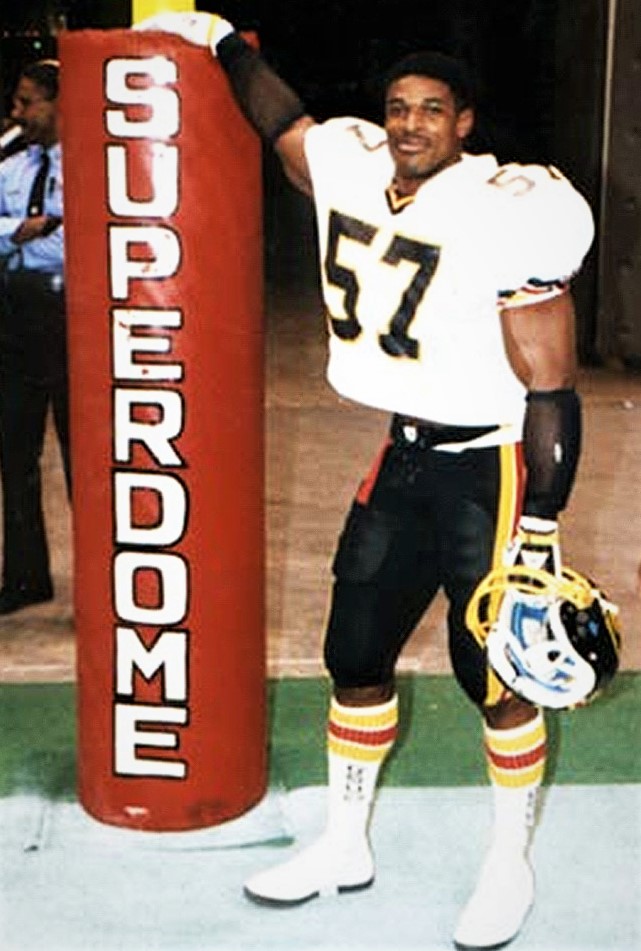
Ronnie Coleman entered and won his first bodybuilding contest in 1990, and only two years later he was competing professionally. Meanwhile, each year from 1991 to 1994 he entered the Texas Deadlift Classic. He pulled 727.5 pounds (330 kg.) in 1994, the year he turned 30 and a year before he won his first pro bodybuilding title. Training hard and heavy in Metroflex Gym in Arlington, Texas, Coleman was nearly as notable for his strength as his physique.
“Eventually, despite my utmost caution and being at the chiropractor at least once a week, it was only going to be a matter of time before the injuries I had suffered [on] the football field and [on] the powerlifting team were going to be exacerbated and come back to bite me,” Ronnie Coleman writes in his autobiography. It happened while squatting 600 in 1997 when he severely herniated a disc. In an interview with Joe Rogan, Coleman said:
“I was squatting 600—I can remember like it was yesterday—I was coming up on rep number eight, and all of sudden—BOW!—it was a loud, gunshot sound. I’d do 600 for like 12-13 reps all the time. This time I took two weeks off [before that leg workout], and I thought I was still as strong as before I took the time off, but I wasn’t. I lost a little strength, and that’s why that disc snapped on me like that. I heard it and I felt it, but, you know, the athlete in you is like: Let’s go on and finish this up. Every time I finished up working out, doing legs, I always had a real bad pain in my back, every single time, but it would always go away in like an hour. This day it didn’t.”
Coleman finished the leg workout, but when the pain wouldn’t go away he visited the emergency room. An MRI revealed a herniated disc, and he was told he needed surgery. But he refused while his bodybuilding stock was rising rapidly. He took two weeks off, but then on his first day back in Metroflex Gym he was squatting again.
RONNIE COLEMAN HEAVY TRAINING
In 1998, Coleman won his first of a record-tying eight consecutive Mr. Olympias. While he was defending the ultimate bodybuilding title every autumn and traveling the globe as muscledom’s ambassador, there was no time for surgery. And there was no lightening up. Ronnie grew ever bigger and stronger.
In 2000, in preparation for his third Mr. Olympia win, he deadlifted 755 lbs. for four reps and then 800 lbs. (362.9 kg.) for two reps. In 2003, in preparation for his sixth Mr. Olympia win, he squatted 800 lbs. for two reps. Both of these incredible lifts were not part of his regular training. Instead, he did them for workout videos, which he then sold on DVD. Still, he always trained heavy. For example, he did a 495-pound bench press for five reps in 2003.
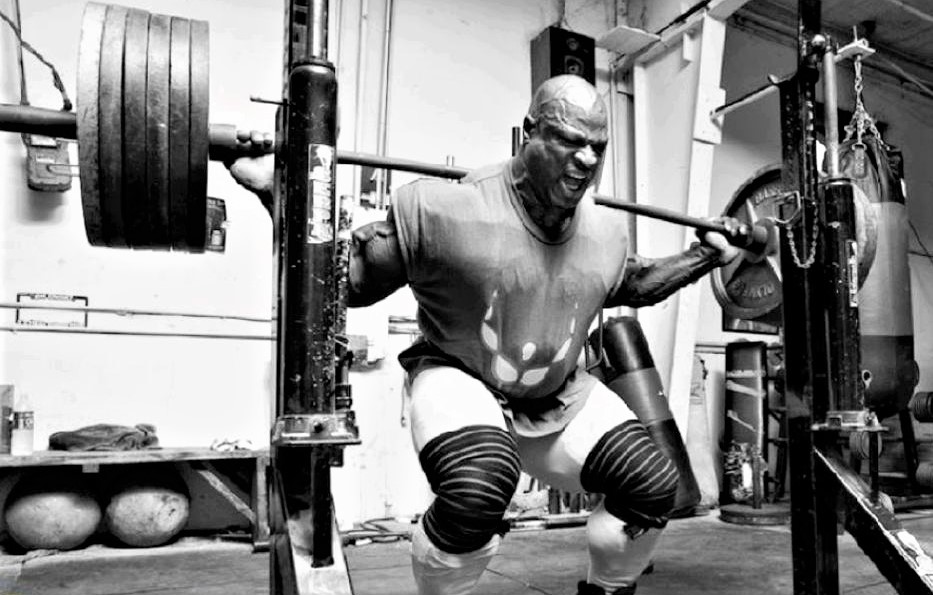
But let’s concentrate on the barbell squat, the exercise he blamed for his initial injury as a teenager and his first herniated disc while training in 1997. As long as he was competing, Ronnie Coleman kept right on squatting heavy. I witnessed him squat 585 pounds for 10 reps, all of them deep, in 2005 before his eighth and final Mr. Olympia win, going until his nose bled. That calculates to approximately the same single he would’ve got in 2003, but this time he wasn’t wearing a suit and didn’t even have a spotter. He was also 41. The next year, at 42, he front squatted 495 for 10 reps. He just kept going and going, training legs twice weekly, back squats in one workout, front squats in the other.
For the definitive account of Ronnie’s biggest lifts, check out: How Strong was Ronnie Coleman?
RONNIE COLEMAN SURGERIES
Ronnie Coleman competed for the last time at the 2007 Mr. Olympia. Only then did he finally address his back pain with the spinal surgery a doctor recommended 10 years prior, before he won eight Mr. Olympias and before a few 1000 more sets of squats. It was the first of many such surgeries, none of them truly successful. He had both hips replaced in 2014. In December 2015, he got off an airplane in Russia after a long flight, and noticed his back was especially sore. It only got worse. Two days later, he was on crutches, and he’s needed them to walk distances ever since. The next month, back in Texas, he had back surgery that lasted 13 hours, and according to Coleman “everything was downhill from there.”
In 2018 alone, he had three spinal surgeries (his 8th, 9th, and 10th): one to fuse vertebrae, another to fix screws from the previous surgery that had broken, and a third to replace all the screws with bigger screws.
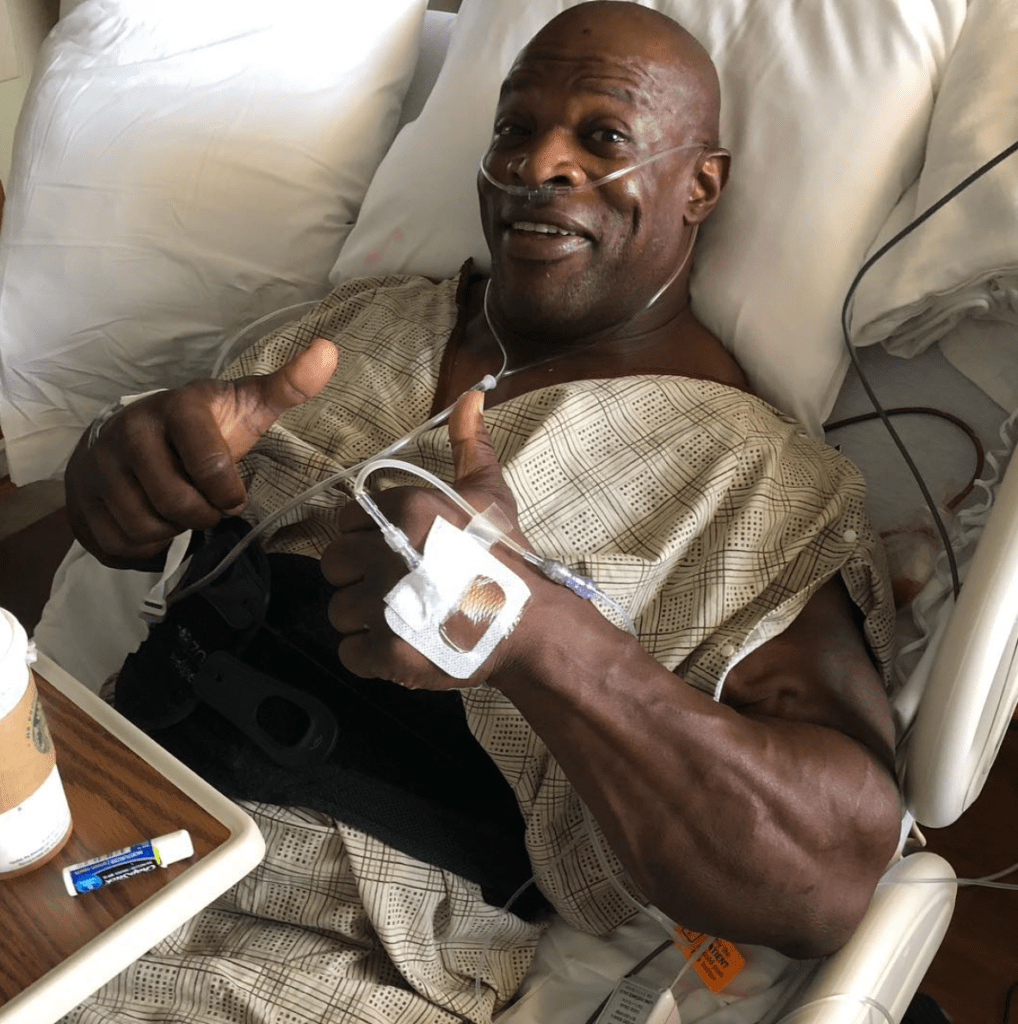
In an interview afterward his third surgery in 2018, he said:
“I don’t know if [walking without crutches] will ever happen because I’ve had too much damage done to my body from all these surgeries. A lot of it has to do with the way the surgeon performed the surgery; and the surgeon that I’ve had the last three surgeries has been really bad and caused a lot of damage to my body. So I don’t know if I’ll be able to walk, but I’m gonna give it my best shot. But I think if that surgeon had to perform these surgeries right then I would have been walking a long, long time ago….Just the way [the surgeon] did everything and performed everything it was like he was kind of doing these surgeries to make money, ’cause every surgery I’ve had done was like $300,000 to $500,000. The last three surgeries I had I spent almost $2 million dollars.”
Those weren’t Ronnie Coleman’s final surgeries. In 2020, having broken a socket, he had both hips replaced again! All told, he’s had 13 surgeries: to his hips (twice), his neck (twice), and his back (nine times). He’s had surgery on all 25 spinal discs. His entire spinal column is fused, except for one disc, which is now herniated! In the interview with Joe Rogan in 2020, Coleman said of his rebuilt spine: “I’ve got 14 screws, two cages [to hold discs together], two rods about this long [18 inches] in there, too.”
RONNIE COLEMAN NOW
Today, Ronnie Coleman can only walk short distances without crutches. Beyond that his legs begin to feel too weak to hold him because of the nerve damage in his back. He still works out regularly, though with only light weights, and he still sticks to a bodybuilder’s diet, though for only three meals daily (not the six or more he ate during his years as a competitive bodybuilder). He turned 59 on May 13. He owns his own successful nutritional supplement line. He’s married with four young daughters. He recently put his longtime Arlington, Texas, house up for sale to move his family of six into a larger abode.
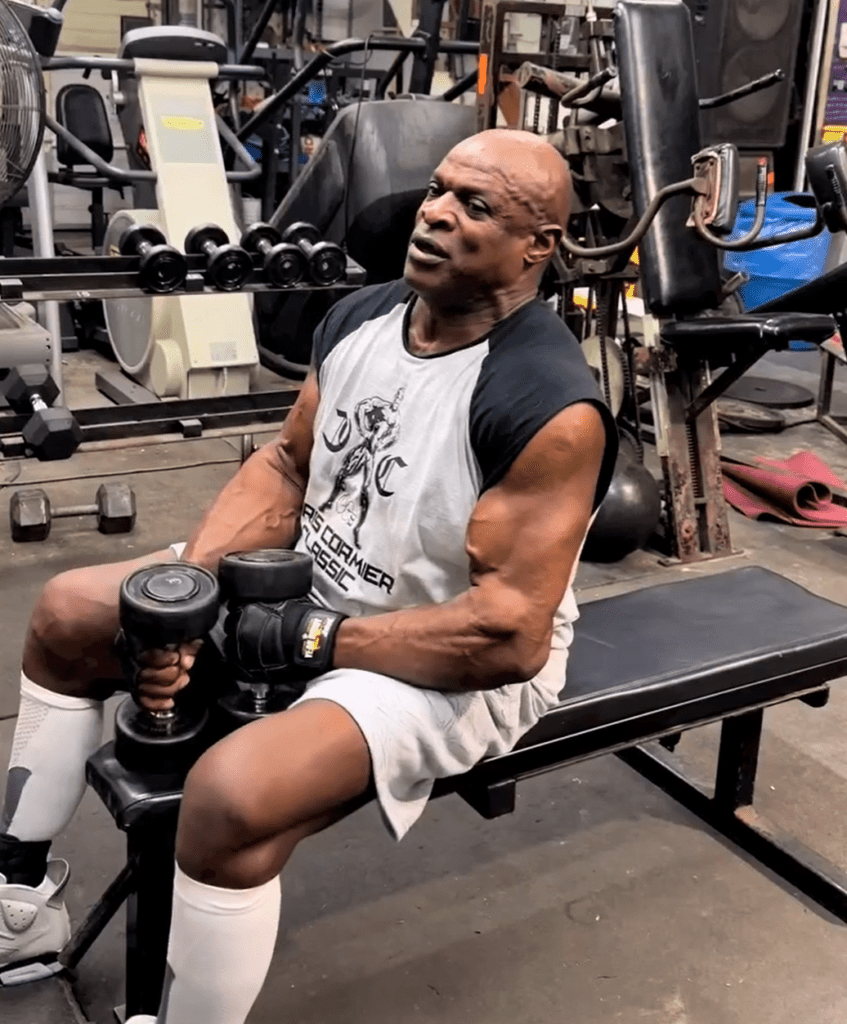
Joe Rogan asked about Ronnie’s continuing to lift weights: “Does it give you any pause at all knowing that you’ve been through all these surgeries?”
Coleman: “No, when you’re doing something that you truly love and enjoy doing, that’s what you look forward to doing all the time, regardless of how you feel. Of course, I’m still in pain and all that kind of stuff.”
Rogan: “Are you in pain all the time?”
Ronnie: “Yeah, but long as I’m doing what I love doing I’m okay. You take that away and I won’t be okay.”
Ronnie Coleman continues to pursue avenues to relieve his pain and regain his mobility. Since October 2020, as Rogan suggested, Coleman has repeatedly received stem cell treatments and hyperbaric therapy at a clinic in Puerto Vallarta, Mexico. After one such treatment, he wrote on Instagram: “As long as I have a plan I have a chance. As long as I’m alive I have a chance to survive and overcome this obstacle.”
WHAT HAPPENED TO RONNIE COLEMAN: CONCLUSION
Is there a lesson to be learned from Ronnie Coleman’s tale? A lot of people seem to think so. Yes, Coleman has a record eight Mr. Olympia wins, but so does his idol Lee Haney, the legend whose best-known quote is “Stimulate don’t annihilate”—a paean to moderate intensity and weights; and Haney is fit as can be at 63. Arnold has seven O wins with no known pain or mobility issues at 75; he bike rides to Gold’s Gym daily. Phil Heath also has seven and is going strong at 43. Dorian Yates, with six Olympia wins, is celebrated for his high-intensity and heavy weights back in the ’90s. He suffered some muscle tears. But Yates avoided free-weight squats beyond his first few years of training and is today, at 61, a dedicated bicyclist and yoga practitioner.
So was it the heavy squats that wrecked Ronnie Coleman’s mobility? He pinpoints his first herniated disc to a squat session in 1997. But he doesn’t blame heavy weights. No, he blames genetics and, most of all, botched surgeries. He did a lot of heavy lifting for the decade after herniating his disc. Would things had been different had he got the surgery right away in ’97? We just don’t know. Maybe he’d be able to walk and run and live pain-free today. But judging by how unsuccessful the surgeries have been, it’s also possible he only would’ve accelerated his decline and perhaps never been Mr. Olympia.
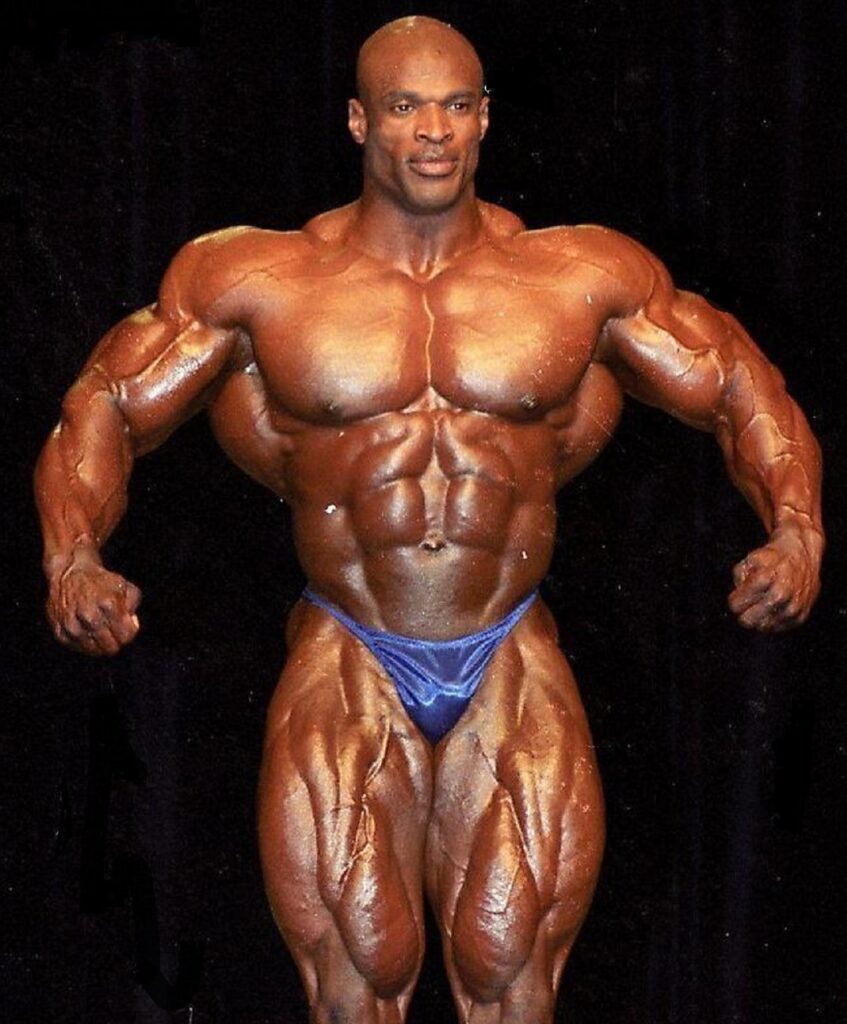
And what if, like Dorian Yates and Phil Heath and most modern bodybuilding champions, he stopped doing free-weight squats by the time he stepped on a pro stage? What if he never did heavy deadlifts either? What if, like Lee Haney, he trained to stimulate not annihilate and never tested his strength with ever-greater weights? Yes, what if? He might be as mobile as Arnold at 75. But then he wouldn’t be the Ronnie Coleman we immortalize, as celebrated for his incredible strength two decades ago as for his stupendous physique.
Does he have regrets? He has one. When asked about the 800-pound squat in 2003, he told me he only wished he’d kept going after the second rep. He’d been focused on getting two, but when he racked the bar he felt he had more reps in him that day. His only regret was not doing more, not setting the mark higher, not pushing himself even further. That’s Ronnie.
“I did it my way,” eight-time Mr. Olympia Ronnie Coleman told me a few years ago, as he sat with his crutches resting beside him. “This is what worked for me. This is the price I paid to be a legend.”
Related Content:
Ronnie Coleman, Natural: When Was He Drug-Free?
Lower Back Injury from Lifting: Prevention and Treatment
















































